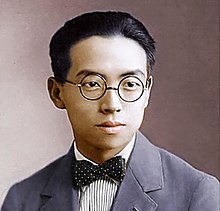
Back ليانج سيتشينج ARZ Liang Sicheng German Liang Sicheng French Liang Sicheng ID 梁思成 Japanese 량쓰청 Korean Liang Sicheng NB Liang Sicheng Portuguese Лян Сычэн Russian Лян Сичен Ukrainian
Liang Sicheng | |||||||||||||||||||
|---|---|---|---|---|---|---|---|---|---|---|---|---|---|---|---|---|---|---|---|
 Liang (before 1949). | |||||||||||||||||||
| Born | 20 April 1901 | ||||||||||||||||||
| Died | 9 January 1972 (aged 70) | ||||||||||||||||||
| Alma mater | Tsinghua University University of Pennsylvania | ||||||||||||||||||
| Spouse(s) | Lin Huiyin Lin Zhu | ||||||||||||||||||
| Children | Congjie Zaibing | ||||||||||||||||||
| Parent | Liang Qichao | ||||||||||||||||||
| Chinese name | |||||||||||||||||||
| Chinese | 梁思成 | ||||||||||||||||||
| |||||||||||||||||||
Liang Sicheng (Chinese: 梁思成; 20 April 1901[1] – 9 January 1972) was a Chinese architect and architectural historian, known as the father of modern Chinese architecture. His father, Liang Qichao, was one of the most prominent Chinese scholars of the early 20th century. His wife was the architect and poet Lin Huiyin. His younger brother, Liang Siyong, was one of China's first archaeologists.
Liang authored the first modern history on Chinese architecture, and he was the founder of the Architecture Department of Northeastern University in 1928 and Tsinghua University in 1946. He was the Chinese representative of the Design Board which designed the United Nations headquarters in New York City. He, along with wife Lin Huiyin, Mo Zongjiang, and Ji Yutang, discovered and analyzed the first and second oldest timber structures still standing in China, located at Nanchan Temple and Foguang Temple at Mount Wutai.
He is recognized as the "Father of Modern Chinese Architecture". Princeton University, which awarded him an honorary doctoral degree in 1947, issued a statement praising him as "a creative architect who has also been a teacher of architectural history, a pioneer in historical research and exploration in Chinese architecture and planning, and a leader in the restoration and preservation of the priceless monuments of his country."
- ^ Liang reported his birth year as 1902 at University of Pennsylvania and to the United Nations Design Board.
© MMXXIII Rich X Search. We shall prevail. All rights reserved. Rich X Search